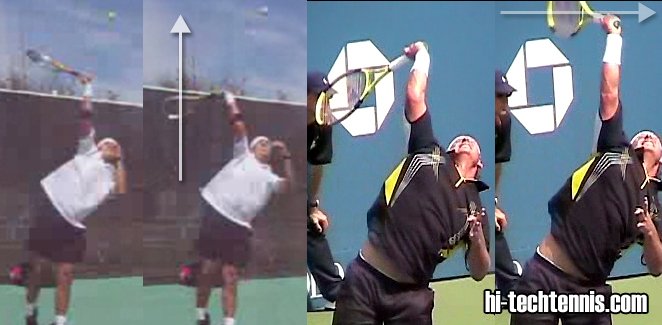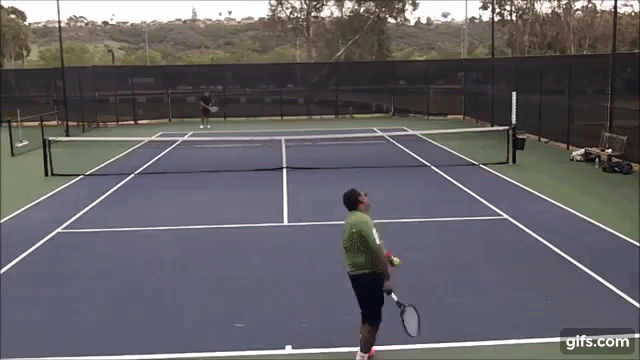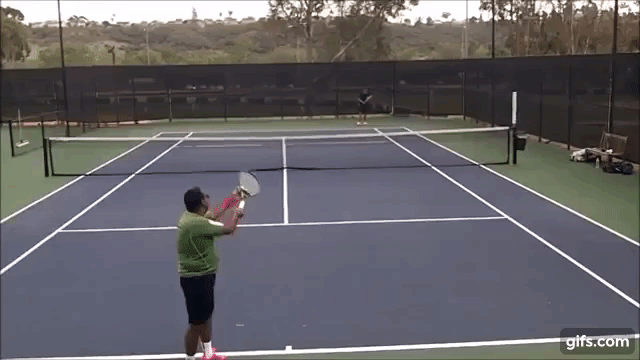Hi, I'm new to the forum. Here's a little background on me:
47 year old male
6' 3" tall left hander, reasonably fit
One handed backhand (mostly slice, but learning a topspin backhand in the past couple months)
Semi-western forehand
Former collegiate baseball player (pitcher)
I live in Georgia and can play year round with a tennis court about 150 yards from my front door.
If I had to guess about my rating, taking the entirety of my game into account, and mostly my lack of consistency, I would not rate myself higher than 3.0.
I am involved in a very little bit of club level competition - on some local leagues playing Mixed Troubles (as my coach calls it) with my wife, but that is mostly a source of frustration for both my wife and I right now.
From age 7 or so, I always played tennis as a "something to do" activity while growing up, but never in any organized fashion, and only when I wasn't playing baseball. I'd pick up my $5 K-mart racquet, call a buddy, and walk, bike, and later drive to a nearby court, or if nobody was around, go hit against the wall by the high school courts. Scholastic tennis (my parents would not have been able to afford any other type of instruction for me) ran in the same season as baseball so despite my interest, I never could participate in that.
I've always had some aptitude for the sport, good hand-eye coordination, quick hands and feet, though I sprint like I am dragging a piano, and as a kid/teenager would try to have that AWSUM serve that I watched on TV!! I would bomb maybe 17 or 18 out of 20 serves way way long or wide, and serve a dinky 2nd, but those 2 or 3 first serves out of 20 that would go in... oh boy!
I found myself at the beginning of this year having just turned 47, wanting an activity to enjoy with my wife (so she would not make me get into a gym - I HATE pushing around plates and treadmills). So I guess you could say I started to actually pay attention to my tennis game this year.
So now, and since January of this year I've been playing and practicing an average of 6 or 7 days a week, usually for around 2 hours per day, but some days as little as one hour, others as many as 4 or 5 hours, over multiple sessions with various hitting partners.
I find myself without the same strength from my teen years, but having ironed a few details out with my serve via some online video instruction. The trouble is that I can serve one day like a 4.0+ player - seriously: in the 100 mph neighborhood, upwards of 85% in (not great on accuracy with respect to wide, up the T, or body serves), and against my regular hitting partners (not just my wife) near 100% first serve points won, better than 75% of them aces, with the remaining being mostly desperation shots that I can just smash/put away on the next hit with nex to no effort. On those days, it seems that the harder and more recklessly I hit my serve, the more solidly and firmly IN the serves seem to go. Sometimes on those days I don't even hit a "real" second serve, because I know that I might have *just* missed the first serve, so I smash my second one just a little bit better and it's in. I might see one double fault in 10 service games on those days.
Then the next day, and once in a while, even within a given playing session/match, I can't hit even a dink second serve in and am double faulting a minimum of twice every service game. My serve game goes from the sublime to the ridiculous.
It's maddening.
The thing is this: I don't know what I'm doing on my 'great serve' days vs. my 'garbage serve' days. I don't know how to fix what is happening other than to just take almost everything off of my serve and hit something barely harder than a dink serve just to keep the thing in play... and it is demoralizing to watch my playing partners on those days just tearing up my first OR second serves (if I even get one in), when just yesterday they were as demoralized as I aced them over and over...
The way I have approached my serve is similar to the way I approached pitching in baseball. On the mound, (from about age 12 on) I had reasonable confidence that I could reach back and throw the fastball where I wanted, or the curve, or the change or the knuckle, and if one of my pitches wasn't as great as the others on a given day, or the hitter was a good fastball hitter, or whatever, I had options to work around it. If my fastball was up or not in the strike zone, I could go through my mechanics points in my head, like dots on a graph, and if I connected them, I'd be reasonably assured my fastball/curveball, etc. would go where I wanted it to. The conversation in my head would be like "Ok, me and you catcher... OK... bend your back, squeeze a little on the index finger, keep your glove hand tucked, feel your right shoulder brush under your chin as you wind up, follow through, don't overthrow, me and the glove, see the target, don't aim it, it'll go where you want it..."
I cannot do this with my serve.
My wife and I take lessons from a local pro twice a week and he keeps telling me "you've got to get into the rhythm and flow of it, you need casual power". Well I've got what feels like casual power, but some days it goes in and some days it doesn't and I don't know what the dots are that need to be connected to result in a serve I can count on. To be fair, our coach is (at our request) mostly focused on my wife's serve in our lessons since she is desperate to learn how not to "serve like a girl" (her words, not mine).
Is this an issue with the type of instruction I am getting? Is the serve taught this way? Is it all too individual to be able to be formulaic from player to player? I keep looking for these mechanics dots to connect, but can't find/see them on my good days to try to emulate them on my bad days. On my bad days, I can't even seem to find something to stop the bleeding... I don't have a "square one" to go back to on those days it seems.
I would appreciate any sort of systems you folks could point me to about this or any advice on how to self-coach or pretty much just any thoughts you folks might have, because I am pretty desperate to at least have an average serve performance that I at least know I can count on not to be a guaranteed winner for my opponent if I even get the thing in play...
Thanks for reading!
47 year old male
6' 3" tall left hander, reasonably fit
One handed backhand (mostly slice, but learning a topspin backhand in the past couple months)
Semi-western forehand
Former collegiate baseball player (pitcher)
I live in Georgia and can play year round with a tennis court about 150 yards from my front door.
If I had to guess about my rating, taking the entirety of my game into account, and mostly my lack of consistency, I would not rate myself higher than 3.0.
I am involved in a very little bit of club level competition - on some local leagues playing Mixed Troubles (as my coach calls it) with my wife, but that is mostly a source of frustration for both my wife and I right now.
From age 7 or so, I always played tennis as a "something to do" activity while growing up, but never in any organized fashion, and only when I wasn't playing baseball. I'd pick up my $5 K-mart racquet, call a buddy, and walk, bike, and later drive to a nearby court, or if nobody was around, go hit against the wall by the high school courts. Scholastic tennis (my parents would not have been able to afford any other type of instruction for me) ran in the same season as baseball so despite my interest, I never could participate in that.
I've always had some aptitude for the sport, good hand-eye coordination, quick hands and feet, though I sprint like I am dragging a piano, and as a kid/teenager would try to have that AWSUM serve that I watched on TV!! I would bomb maybe 17 or 18 out of 20 serves way way long or wide, and serve a dinky 2nd, but those 2 or 3 first serves out of 20 that would go in... oh boy!
I found myself at the beginning of this year having just turned 47, wanting an activity to enjoy with my wife (so she would not make me get into a gym - I HATE pushing around plates and treadmills). So I guess you could say I started to actually pay attention to my tennis game this year.
So now, and since January of this year I've been playing and practicing an average of 6 or 7 days a week, usually for around 2 hours per day, but some days as little as one hour, others as many as 4 or 5 hours, over multiple sessions with various hitting partners.
I find myself without the same strength from my teen years, but having ironed a few details out with my serve via some online video instruction. The trouble is that I can serve one day like a 4.0+ player - seriously: in the 100 mph neighborhood, upwards of 85% in (not great on accuracy with respect to wide, up the T, or body serves), and against my regular hitting partners (not just my wife) near 100% first serve points won, better than 75% of them aces, with the remaining being mostly desperation shots that I can just smash/put away on the next hit with nex to no effort. On those days, it seems that the harder and more recklessly I hit my serve, the more solidly and firmly IN the serves seem to go. Sometimes on those days I don't even hit a "real" second serve, because I know that I might have *just* missed the first serve, so I smash my second one just a little bit better and it's in. I might see one double fault in 10 service games on those days.
Then the next day, and once in a while, even within a given playing session/match, I can't hit even a dink second serve in and am double faulting a minimum of twice every service game. My serve game goes from the sublime to the ridiculous.
It's maddening.
The thing is this: I don't know what I'm doing on my 'great serve' days vs. my 'garbage serve' days. I don't know how to fix what is happening other than to just take almost everything off of my serve and hit something barely harder than a dink serve just to keep the thing in play... and it is demoralizing to watch my playing partners on those days just tearing up my first OR second serves (if I even get one in), when just yesterday they were as demoralized as I aced them over and over...
The way I have approached my serve is similar to the way I approached pitching in baseball. On the mound, (from about age 12 on) I had reasonable confidence that I could reach back and throw the fastball where I wanted, or the curve, or the change or the knuckle, and if one of my pitches wasn't as great as the others on a given day, or the hitter was a good fastball hitter, or whatever, I had options to work around it. If my fastball was up or not in the strike zone, I could go through my mechanics points in my head, like dots on a graph, and if I connected them, I'd be reasonably assured my fastball/curveball, etc. would go where I wanted it to. The conversation in my head would be like "Ok, me and you catcher... OK... bend your back, squeeze a little on the index finger, keep your glove hand tucked, feel your right shoulder brush under your chin as you wind up, follow through, don't overthrow, me and the glove, see the target, don't aim it, it'll go where you want it..."
I cannot do this with my serve.
My wife and I take lessons from a local pro twice a week and he keeps telling me "you've got to get into the rhythm and flow of it, you need casual power". Well I've got what feels like casual power, but some days it goes in and some days it doesn't and I don't know what the dots are that need to be connected to result in a serve I can count on. To be fair, our coach is (at our request) mostly focused on my wife's serve in our lessons since she is desperate to learn how not to "serve like a girl" (her words, not mine).
Is this an issue with the type of instruction I am getting? Is the serve taught this way? Is it all too individual to be able to be formulaic from player to player? I keep looking for these mechanics dots to connect, but can't find/see them on my good days to try to emulate them on my bad days. On my bad days, I can't even seem to find something to stop the bleeding... I don't have a "square one" to go back to on those days it seems.
I would appreciate any sort of systems you folks could point me to about this or any advice on how to self-coach or pretty much just any thoughts you folks might have, because I am pretty desperate to at least have an average serve performance that I at least know I can count on not to be a guaranteed winner for my opponent if I even get the thing in play...
Thanks for reading!
Last edited:



